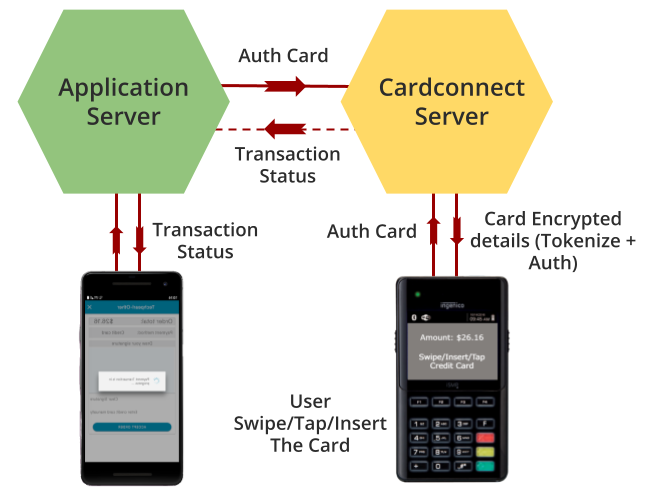
Building AI Agents: The Architecture Guide We Wish We Had
Building AI Agents: The Architecture Guide We Wish We Had Building AI agents turned out to be one of those adventures that started with wide-eyed

All e-commerce applications offer credit card payments with payment gateway integrations.
Apart from the regular online payment integration, there is also a need to integrate the app with the physical card swiping machines in some business scenarios.
In this article, I will walk you through the integration of cardconnect bolt devices for credit card payments, with an ionic application.
Bolt device :

Payment gateway is a third party solution between a customer and merchant which enables the money transfer between a customer’s account and a merchant’s bank account. This includes the authorisation of online transactions through different payment modes like net banking, credit card, debit card, UPI or online wallets that are available these days. These also support services like refund in case of cancellation of order.
Cardconnect, PayPal, Authorize.net are some of the well known payment gateways.
There are a few key terms one has to be familiar with when dealing with credit card transactions, be it online transactions or integration with a swipe machine.
Credit card tokenization is the process of completely removing sensitive data from a company’s internal network by replacing it with a randomly generated, unique placeholder called a token.
Payment gateway secures the sensitive information given by the user throughout the process. Payment gateway tokenises or encrypts the card details and performs fraud checks before sending the data to the acquiring bank.
Credit card authorization is an approval that the customer has sufficient funds on their card to pay for the transaction
A credit card capture is a legally binding step that takes place after a payment authorization that officially moves a customer’s funds into the designated merchant account.
Actual money transfer is handled by this process. This can be automatic immediately after authorisation or manual during the authorisation hold. Generally for credit cards authorisation may last as long as for 30 days duration.
In case a customer cancels the order or returns the item purchased. If a transaction is in a settled state the refund request is raised to the credit card payment processor, through the payment gateway.
When a credit card transaction is authorised but not captured, a transaction can be voided to cancel the authorisation.
You can read more about integration requirement overview here

Users can swipe/tap/insert the credit card. This takes the confirmation for the amount. Card decline message is displayed in case of the card being declined.
Bolt terminal reads the credit card information and send it to cardconnect for tokenization
This API takes care of tokenization of the credit card, making the Authorization request call to cardconnect and returns the retrieval reference number to use in subsequent calls like Capture, Void,Refund.
On receiving the response, ‘disconnect’ call is made to disconnect the device, close the session and release the session key.
https://developer.cardconnect.com/bolt-terminal#disconnect
Note: It can be integrated with angular web application too.
As per the business requirement we can manage multiple terminals (swiper devices) along with the application devices.
We have used Hardware Serial Numbers (HSN) of the bolt terminal and the application device’s unique identification number for pairing.

Building AI Agents: The Architecture Guide We Wish We Had Building AI agents turned out to be one of those adventures that started with wide-eyed

Angular Best Practices for Scalable and High-Performance Applications Introduction Staying current with Angular’s latest features is key to writing efficient, scalable, and maintainable applications. This

Breaking the API Mold: A new era of AI-Driven Customer Journeys In the fast- paced world of financial services, speed, accuracy and scalability are critical.
| Cookie | Duration | Description |
|---|---|---|
| cookielawinfo-checkbox-analytics | 11 months | This cookie is set by GDPR Cookie Consent plugin. The cookie is used to store the user consent for the cookies in the category "Analytics". |
| cookielawinfo-checkbox-functional | 11 months | The cookie is set by GDPR cookie consent to record the user consent for the cookies in the category "Functional". |
| cookielawinfo-checkbox-necessary | 11 months | This cookie is set by GDPR Cookie Consent plugin. The cookies is used to store the user consent for the cookies in the category "Necessary". |
| cookielawinfo-checkbox-others | 11 months | This cookie is set by GDPR Cookie Consent plugin. The cookie is used to store the user consent for the cookies in the category "Other. |
| cookielawinfo-checkbox-performance | 11 months | This cookie is set by GDPR Cookie Consent plugin. The cookie is used to store the user consent for the cookies in the category "Performance". |
| viewed_cookie_policy | 11 months | The cookie is set by the GDPR Cookie Consent plugin and is used to store whether or not user has consented to the use of cookies. It does not store any personal data. |